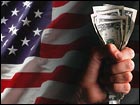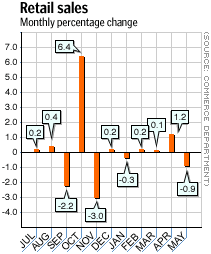
NEW YORK (CNN/Money) -
U.S. consumers may seem tireless, but could it be time for them to take a breather?
Consumer spending, the $6.6 trillion engine pulling the $9.5 trillion U.S. economy, never faltered during a recession that began in March 2001, despite plunging stock values, the Sept. 11 terror attacks and the threat of more attacks, more than a million job cuts and an unemployment rate at seven-year highs.
But some economists think this is an unnatural reaction that cannot continue -- consumers won't keep spending forever, with debt levels rising and jobs scarce.
And most economists -- including Federal Reserve Chairman Alan Greenspan -- have warned there must at least be some payback for the surprising growth of consumer spending in the last three quarters of 2001, when the economy was at its worst.
"Because there was little retrenchment during the cyclical downturn, the potential for a significant acceleration in activity in the household sector is likely to be more limited than in past business cycles," Greenspan told Congress, way back in April.
Sure enough, consumer spending, as measured by the Commerce Department in its report on gross domestic product (GDP), grew only 3.2 percent in the first quarter of 2002 and is on pace, according to many economists, to grow at a measly 1.5 percent rate in the second quarter.

"This is what the Federal Reserve has been warning about for a long time -- we will still see consumer spending growth, but it will be more moderate than before," said Brown Brothers Harriman economist Lara Rhame, a former Fed economist. "It's a retrenchment of consumer spending growth from blistering levels."
And retail sales fell 0.9 percent in May, according to the Commerce Department, the biggest drop in six months. Many economists said retail-sales data are notoriously volatile, that cold, rainy weather kept shoppers out of stores in May and that sales have already recovered in the first week of June.
"June numbers were extremely strong, which suggests May's weakness really was the weather -- that it was not just an excuse," said Delos Smith, economist at the Conference Board, which produces a closely watched monthly survey of consumer confidence.
On the other hand, Kurt Barnard, President of Barnard's Retail Consulting, pointed out that Wal-Mart (WMT: Research, Estimates) and other discount stores were not affected by the weather, indicating shoppers were worried more about prices than a few raindrops.
"Americans have become very cautious spenders, and that was extremely evident in May," Barnard said. "Retail sales will continue to advance, but very slowly, very cautiously."
Signs of retrenchment
Consumers have recuperated from recessions in the past by tightening their wallets and repairing their balance sheets. In the 1990-92 recession/recovery period, for example, consumer spending shrank in three different quarters. It has never fallen since, even during the disastrous third quarter of 2001.
But Americans lately are more in debt and earning less. As a result, they are socking more away in savings:
- According to the Federal Reserve, 6.37 percent of Americans' disposable income went to mortgage payments in the fourth quarter -- the highest rate since the Fed started keeping track in 1980.
- And consumer debt service, including credit-card payments, rose to 7.93 percent in the fourth quarter -- the highest rate since the third quarter of 1987
- Combined, debt service took 14.3 percent of disposable income in the quarter -- the highest rate since the fourth quarter of 1986.
- Meanwhile, according to the Labor Department, real weekly earnings fell 0.7 percent in April, the biggest drop since March 2000, thanks in part to a surge in consumer prices.
- And the Commerce Department said Americans saved $223.3 billion in the first quarter of 2002, the biggest amount of savings -- not counting the unusual third quarter of 2001, which included the Sept. 11 terror attacks that brought consumer spending to a virtual stand-still -- since the first quarter of 1999.
"If you stash money away in a savings account, then there's less available to buy things in a store, from candy to cars," Barnard said. "This is not quite the conventional retrenchment we've known from past recessions, but it may represent a kind of wishy-washy stagnation."
| 
| |
| | |
|
Last year was a big year for liquefying home equity -- about $100 billion. That's a drop in the bucket compared to $7 trillion.
| |
| | |
| 
| |
| | |
|
Frank Nothaft
Freddie Mac economist
| |
|
On the other hand, the robust housing market doesn't seem ready to fall off the table any time soon. Relentlessly low mortgage rates have pushed home values higher, boosting consumers' net worth. Low rates also fueled a red-hot refinancing market, which homeowners used to cut mortgage payments and cash in on rising home equity.
Some economists have warned that the goose of refinancing only has a limited number of golden eggs to spare. But the Mortgage Bankers Association of America said Wednesday that continuing low mortgage rates could be setting the stage for yet another wave of refinancing activity.
"There's about $6 trillion in single-family mortgage debt outstanding, and total home value is about $13 trillion, which means there's about $7 trillion in home equity outstanding," said Frank Nothaft, chief economist at mortgage security firm Freddie Mac (FRE: Research, Estimates). "Last year was a big year for liquefying home equity -- about $100 billion. That's a drop in the bucket compared to $7 trillion."
The silver lining
Even if consumer spending does slow down, is that really such a disaster for the economy? It may actually not be as important these days as business spending -- after all, if that picks up again, then production will accelerate, leading to new hiring and happier consumers.
"At this point, consumers aren't the only thing keeping the economy going," Bill Cheney, chief economist at John Hancock Financial Services, told CNNfn's CNNmoney Morning program. "We have the federal government on a sort of fiscal binge of tax cuts and spending programs. And you've got business spending, which may not be growing fast, but at least it's stopped plummeting. So we're not half as dependent on the consumer ratcheting up spending every single month as we would have been, say, six months or a year ago."
| |
 Related links
Related links
| |
| | |
| | |
|
And a silver lining to less-than-frenetic consumer spending is that it will keep the Fed on the sidelines. The central bank's key short-term interest rate target is at a 40-year low, where it's been all year, and few economists think monetary policy makers are in any hurry to start raising rates.
"While the economy may be recovering, it's not going to recover at a rate that puts upward pressure on inflation to any measurable extent," Cheney said, "so that means the Fed is going to be on the sidelines for quite some time, and we can sort of let the economy rip."

|

